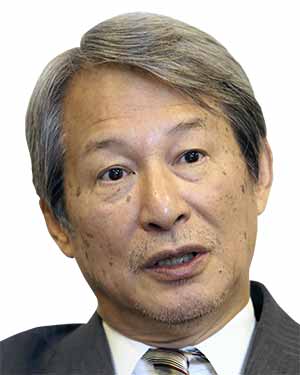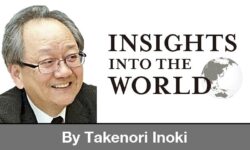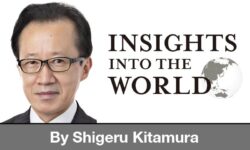16:03 JST, May 12, 2023
We often come across the term “Global South” these days. It was originally coined as an antonym of advanced countries in the “North” to refer to developing ones in the “South,” many of which used to be colonized by the former.
During his visit to India in March, Prime Minister Fumio Kishida noted in a speech that as the so-called Global South grows, “the means of sharing responsibility for global governance will become an increasingly important issue.”
He plans to invite the leaders of key Global South countries such as India, Indonesia and Brazil to this year’s Group of Seven summit scheduled for May 19-21 in Hiroshima.
So, what kind of strategic and political meaning does the Global South have?
This term emerged during the Cold War to refer neither to the “West” (i.e., the First World) nor the “East” (the Second World), but to “the Rest” (the Third World). That was why India, Indonesia and some other countries representing the Third World campaigned for nonalignment and neutrality.
With the “East” gone with the end of the Cold War, the Global South became a metaphor for poverty, inequality and marginality. Then, in the middle of the 2010s, it began being used time and again as a geopolitical term to depict countries classified under the “Rest” category that took no sides between the group constituting the United States, its allies (including Japan) and partners, and that of countries that align with China and Russia.
However, in reality, the Global South is diverse, with countries having many different attributes.
The combined global economic share of developing countries and emerging ones doubled to 40% in 2020 from 20% in 1990, with their global presence increasing predominantly because of the rise of emerging countries. Early in this century, the acronym BRICS, which stands for Brazil, Russia, India, China and South Africa, was widely used as the term to collectively illustrate how fast emerging countries were growing. But nobody would consider all five countries as part of the Global South now.
Iran and South Africa, among some other countries, partner with China and Russia. On the other hand, countries like Sri Lanka have been caught in a debt trap, while others like Sudan have been stricken by the consequences of failures in nation-building. Further, when one thinks of Latin America, a nuclear-free region, and the Middle East, a region with concerns about the possible proliferation of nuclear weapons, it is obvious that the circumstances surrounding international relations differ from region to region.
The Global South is too broad a term to be used to call on developing and emerging countries to share responsibility for global governance. The meaning of the term needs to be rethought by taking individual factors into consideration. This seems to have been one of the reasons that the foreign ministers of the G7 refrained from using the term in their joint communique issued after they met in Japan in April this year.
Deep look at ‘Indo-Pacific’
The same holds true for the term “Indo-Pacific.”
“Indo-Pacific” began to be widely used in the 2010s in lieu of “Asia-Pacific” and “East Asia.” The reason for its emergence is simple.
When the world ushered in the 21st century, China built and militarized artificial islands in the South China Sea and began bringing economic pressure to bear upon other countries to change their policies in favor of Beijing. In this age of sovereign equality, the Chinese leadership has been endeavoring to establish a China-centric order. China’s then Foreign Minister Yang Jiechi famously said in 2010: “China is a big country and other countries are small countries and that is just a fact.”
One of the meanings of the term “Indo-Pacific” is that a group of countries opposing such moves by China comes forward to defend the Indo-Pacific as a free and open world under the “rule of law” and, to that end, cooperate with South Asian and Southeast Asian countries.
However, the situations in South Asia and Southeast Asia are different.
In South Asia, India accounted for 78% of the region’s overall economy as of 2021, way above Bangladesh (10%), Pakistan (9%) and Sri Lanka (2%). In terms of military expenditures, India’s share stood at 80%, far greater than 12% for Pakistan.
India is the power in South Asia, militarily confronting China and Pakistan, both of which, like India, are armed with nuclear weapons. India has joined Japan, the United States and Australia in establishing the Quad security framework out of its wariness of China’s advances in the Indian Ocean via Pakistan and Myanmar and to Sri Lanka.
The Indian elite are confident that their country will emerge as a superpower in the same league with the United States and China by the middle of the 21st century. Therefore, they do not want at all to become a subordinate to either Washington or Beijing. Neither do they feel they should protect by any means the existing world order because India was not involved in its making. In the meantime, given its low per capita gross domestic product of about $2,000, India’s biggest ongoing challenge is to realize sustainable economic growth at home.
As such, it is understandable that the country chooses to behave on an “India-first” basis. In fact, India is advancing economic cooperation with Japan and the United States, while it keeps importing crude oil from Russia at low prices. India upholds a policy of prioritizing domestic economic development. In February this year, India abstained from voting for a U.N. General Assembly resolution that sought investigations into Russia’s alleged war crimes during Moscow’s ongoing invasion of Ukraine. On the other hand, it assumes the role of amplifying the “voice of the Global South” within the Group of 20 economies.
How should Japan get along with a country like India?
There is no choice but to support India on its path to emerging as a power while trying to convince the country to share responsibility for maintaining the global order.
Strengthen ties with ASEAN
The circumstances surrounding Southeast Asia’s international relations differ greatly from those in South Asia. As of 2021, Indonesia accounted for 35% of the overall Southeast Asian economy, followed by Thailand (15%), Singapore (13%) and the Philippines (12%) as well as Malaysia and Vietnam (11% each). As for military expenditures, as of 2018, Singapore had the largest share of 26%, trailed by Indonesia (19%), Thailand (17%), Vietnam (14%), the Philippines (10%) and Malaysia (9%).
As for military expenditures expressed as a percentage of gross domestic product, the relevant figures for Brunei, Myanmar and Singapore are higher, but those for other Southeast Asian countries remain limited to around 1% and are far lower than the comparable figure of about 3% each for India and Pakistan. In Southeast Asia, power is balanced to a certain extent among the countries, and relationships are built on mutual trust fostered for more than half a century by cooperation through the Association of Southeast Asian Nations.
ASEAN annually hosts a series of important “ASEAN-plus” forums, including the East Asia Summit in which the leaders of the ASEAN member states and East Asian/Asia Pacific countries meet. But those frameworks have not been functioning well since 2010, when China intensified its interference in the grouping’s affairs.
Further, in terms of geopolitical interests, there is a big difference between those ASEAN member states that are involved in a dispute with China over the South China Sea and those that are not. While the military presence of the United States is a given on which the security policies of many countries in Southeast Asia are based, China is the largest trading partner of the region.
It is clear from the abovementioned developments why Southeast Asian countries have been dealing with the United States and China amid the Washington-Beijing confrontation by balancing themselves with the two nations either individually or collectively as ASEAN.
ASEAN has issues of its own. With Myanmar becoming an increasingly failed state, it is likely that more refugees will flee the country and lawless areas will spread along its border, serving as a source of drug trafficking, illicit gambling and human trafficking among other problems. Some countries are at risk of falling into a sovereign debt trap. Japan, for its part, should increase close cooperation with strategically important countries such as Vietnam, the Philippines, Indonesia and Thailand so as to help each Southeast Asian country act in unison as ASEAN. Such endeavors will surely bring Japan and ASEAN closer to each other.

Takashi Shiraishi
Shiraishi is the chancellor of the Prefectural University of Kumamoto. Previously, he was the president of the National Graduate Institute for Policy Studies from 2011-17 and the president of the Institute of Developing Economies, Japan External Trade Organization, from 2007-18.
The original article in Japanese appeared in the May 7 issue of The Yomiuri Shimbun.
"Editorial & Columns" POPULAR ARTICLE
-

Violations of Subcontract Law: Major Automakers Must Eliminate Old Practices
-

Local Governments’ Tax Revenues: Devise Ways to Correct Imbalances in Tax Sources
-

5 Japanese Business Dinner Mistakes to Avoid — and What They Taught Me About Business in Japan
-

Heavy Rains in Asia: Support for Victims, Flood-Control Measures Urgently Needed
-

Rice Coupons: A Misguided Approach to Countering Rising Prices
JN ACCESS RANKING
-

Keidanren Chairman Yoshinobu Tsutsui Visits Kashiwazaki-Kariwa Nuclear Power Plant; Inspects New Emergency Safety System
-

Imports of Rare Earths from China Facing Delays, May Be Caused by Deterioration of Japan-China Relations
-

University of Tokyo Professor Discusses Japanese Economic Security in Interview Ahead of Forum
-

Japan Pulls out of Vietnam Nuclear Project, Complicating Hanoi’s Power Plans
-

Govt Aims to Expand NISA Program Lineup, Abolish Age Restriction

























